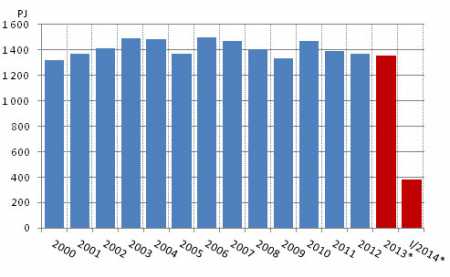|
Fri, 20 Jun, 2014 12:07:23 AM FTimes Report, June 20  Total energy consumption. Source: Statistics Finland. The warm early part of the year decreased total energy consumption in the country by nearly five per cent compared to that of the corresponding period in 2013.
According to Statistics Finland’s preliminary data, it was around 380 petajoule (PJ) in the first quarter of the year, which was nearly five per cent less than in 2013. Electricity consumption amounted to 23.9 terawatt hours (TWh), which is 2.8 per cent lower than in last year's corresponding period.
Imports of electricity from the Nordic countries grew 2.5-fold as a result of good availability of hydro power. For this reason, domestic separate production of electricity went down by 46 per cent, which turned the consumption of coal to a decline. Carbon dioxide emissions in energy production fell by 7.1 per cent from the corresponding period of the last year.
Among individual energy sources, the largest reduction of 25 per cent was seen in the consumption of coal (11 PJ), while the second largest reduction of 15 per cent was recorded in the consumption of natural gas (5.6 PJ). The consumption of oil also decreased by eight per cent (6.2 PJ).
In turn, the consumption of peat grew by 22 per cent in the first quarter of the year (5.4 PJ). This was due to the exceptionally low use of peat last year over the corresponding period. One-quarter of Finland's total energy consumption was covered with wood fuels.
Domestic production of electricity decreased by eight per cent. Twenty per cent of the electricity consumed in Finland was covered with imported electricity. Net imports of electricity increased by 28 per cent in the first quarter.
The volume of electricity imported from Sweden grew 2.5-fold. Imports of electricity from Russia in turn fell by 54 per cent. Exports of electricity to Estonia rose to a new level, 1.2 TWh, which was triple the amount of the corresponding period of the previous year.
Combined heat and power production went down by seven per cent as the demand for district heat decreased on account of the warm early part of the year. The production of wind power grew by 78 per cent.
More News
|
|
Finland Times
| Sunday, 28 April, 2024 |

